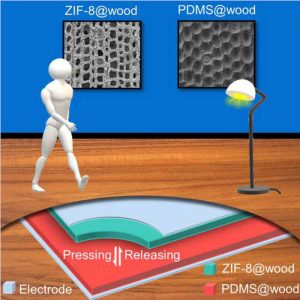Updated: Modified wood turns force into electricity

Two layers of wood are required, one spin-coated with PDMS (polydimethylsiloxane) – an electron acceptor on contact (‘tribo-negative’) – and the other with nanocrystals of ZIF-8 grown in one surface – ZIF-8 (zeolitic imidazolate framework-8) is an electron donating (‘tribo-positive’) ‘metal-organic framework’.
“Wood is basically triboneutral,” said scientist Guido Panzarasa of ETH Zürich and the Swiss Federal Laboratories for Materials Science and Technology (Empa). “It means that wood has no real tendency to acquire or to lose electrons, so the challenge is making wood that is able to attract and lose electrons.”
Not that the wood is a dumb sponge in the structure. Instead, it provides strength and toughness that the naturally triboelectric materials lack, and its surface roughness is required for current generation as this is a form of TENG (triboelectric nanogenerator). A successful TENG surface has to have high nano-scale roughness for high surface area, without tall peaks that will prevent close contact from opposing surfaces.
The wood, in this case 1mm thick, also acts an a insulator, preventing conduction between the tribo-active faces and electrodes on the backs of the sheets.
For current generation, the sheets are operated with their tribo-active surfaces facing (see diagram), and with the external circuit connected between the back electrodes.
Update: How it works
If the tribo-positive ZIF-8-wood is forced against the tribo-negative PDMS-wood, electrons transfer across from the ZIF-8-wood surface until a stable state is achieved – charges cancel and there is no net external electric field.
If the sheets are then allowed to spring apart, the intimate surface contact breaks and the PDMS-wood surface keeps its acquired electrons.
Without close contact with the ZIF-8, the excess electrons in the PDMS layer give it a negative charge.
The opposite thing has happened with the ZIF-8-wood, giving its ZIF-8 layer a positive charge.
The the net effect of these two charges suddenly appearing is to cause electrons to flow between the back electrodes (PDMS-wood electrode to ZIF-8-wood electrode) until the charges are neutralised: a pulse of current has been pushed from ZIF-8-wood to PDMS-wood (thank you very much for this confusion Mr Franklin…)
When the sheets are once more forced together, a pulse of current flows back the other way, and it is these pulses that are rectified and stored for use – the researchers, for example, powered a calculator. See below for a more detailed description of TENG operation.
Of the balsa, spruce and yew wood tested, radially-cut spruce worked best, generating 24V open-circuit and 320μA short-circuit when pressed with 50N of force. Output did not diminish up to 1,500 cycles.
“Our focus was to demonstrate the possibility of modifying wood with relatively environmentally friendly procedures to make it triboelectric,” said Panzarasa. “Spruce is cheap and available and has favourable mechanical properties. The functionalisation approach is quite simple, and it can be scalable on an industrial level. It’s only a matter of engineering.”
The team’s next step is to find chemical coatings with similar function that are easy to use and more eco-friendly. “The ultimate goal is to understand the potentialities of wood beyond those already known and to enable wood with new properties for future sustainable smart buildings,” said Panzarasa.
Full information, including a detailed description of TENG operation, is available without payment in the paper ‘Functionalized wood with tunable tribopolarity for efficient triboelectric nanogenerators‘, published in Matter.